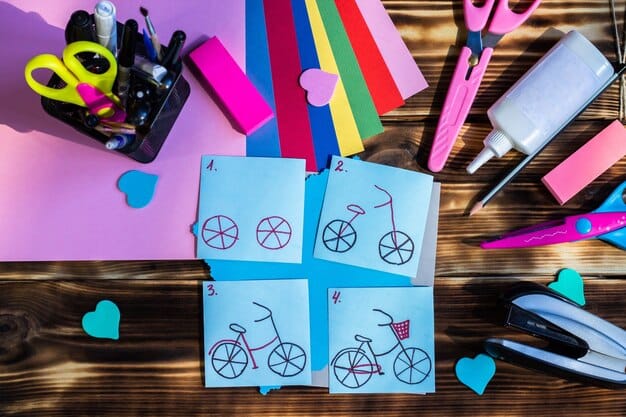Learning Styles & Language Learning: Tailor Your Approach for Success

Learning Styles and Language Acquisition is a personalized approach that optimizes your learning progress by aligning study methods with your individual preferences, leading to more effective and enjoyable language acquisition.
Unlocking fluency in a new language can feel like a daunting task. However, understanding and applying **learning styles and language acquisition** strategies can significantly accelerate your progress, making the entire process more efficient and enjoyable.
Understanding Learning Styles in Language Acquisition
Learning styles refer to the different ways individuals process and retain information. Recognizing your dominant learning style can help you tailor your language learning approach for optimal results. This section explores the main learning styles and their implications for language acquisition.
The VARK Model: Visual, Auditory, Reading/Writing, and Kinesthetic
The VARK model is a popular framework for understanding learning styles. It categorizes learners into four main types: visual, auditory, reading/writing, and kinesthetic. Each type benefits from different learning methods, and understanding these preferences can enhance language learning.
- Visual Learners: These learners benefit from visual aids like flashcards, diagrams, and videos. Using colors and imagery can enhance memory retention.
- Auditory Learners: Auditory learners thrive in environments where they can hear the language being spoken. Podcasts, language partners, and audio lessons are effective tools.
- Reading/Writing Learners: These learners prefer learning through written materials. Textbooks, articles, and writing exercises are beneficial.
- Kinesthetic Learners: Kinesthetic learners learn best through hands-on activities. Role-playing, interactive games, and physical movement can aid in language acquisition.
Identifying your VARK preference allows you to incorporate the most effective strategies into your study routine. If you’re unsure, online questionnaires can help determine your dominant learning style. By tailoring your approach, language learning becomes more efficient and personally rewarding.

The Importance of Tailoring Your Approach
Tailoring your language learning approach based on your learning style can significantly improve your efficiency and enjoyment. When you utilize strategies that align with your preferences, you are more likely to stay motivated and retain information effectively. This section delves into the benefits of personalization and how to implement it.
Personalization makes learning more engaging and memorable. When you enjoy the process, you are more likely to dedicate time and effort. This is particularly crucial for language acquisition, which requires consistent practice and exposure.
Maximizing Retention Through Preferred Methods
When learning methods align with your learning style, information is processed more effectively, leading to greater retention. Visual learners, for example, might remember vocabulary words better if they associate them with images or create mind maps. Auditory learners might benefit from listening to dialogues or songs in the target language.
Implementing a personalized approach can involve various adjustments. For visual learners, using colorful flashcards or watching videos can be beneficial. Auditory learners might find podcasts or language exchange partners helpful. Reading/writing learners can benefit from keeping a language journal or writing essays. Kinesthetic learners can engage in role-playing or physical activities related to the language.
By aligning your study methods with your dominant learning style, you can maximize your retention and accelerate your progress. This personalized approach makes language learning more effective and enjoyable.
Strategies for Visual Learners in Language Acquisition
Visual learners thrive on visual stimulation and often remember information better when presented in a visual format. This section explores specific strategies that visual learners can use to enhance their language acquisition journey.
For visual learners, incorporating visual aids into language study is crucial. This can range from using colorful flashcards to watching engaging videos. The key is to leverage visual elements to reinforce learning and improve retention.

Using Flashcards with Images and Colors
Flashcards are a classic tool for vocabulary learning, but visual learners can enhance their effectiveness by incorporating images and colors. Associating words with pictures and using different colors for different categories can make the flashcards more memorable.
Watching Videos and Films in the Target Language
Watching videos and films in the target language can be a highly effective learning method for visual learners. Pay attention to body language, facial expressions, and visual cues to understand the context and meaning.
- Subtitles: Initially, use subtitles in your native language to ensure comprehension.
- Active Viewing: Pause the video to take notes on new vocabulary or grammar points.
- Repetition: Watch the video multiple times, gradually reducing your reliance on subtitles.
Visual learners can greatly benefit from these strategies by transforming abstract language concepts into tangible visual experiences. By actively incorporating visual aids, language learning becomes more engaging and results in better comprehension.
Techniques for Auditory Learners
Auditory learners excel when information is presented through sound and spoken language. This section provides techniques tailored for auditory learners to effectively master a new language through listening and speaking activities.
Auditory learners thrive in environments where they can immerse themselves in the sounds of the language. Listening to native speakers, participating in conversations, and using audio-based learning tools are highly beneficial.
Listening to Podcasts and Audio Lessons
Podcasts and audio lessons provide a convenient way to immerse yourself in the target language. Choose podcasts that cover topics of interest to maintain engagement and motivation. Audio lessons can provide structured learning with grammar explanations and vocabulary exercises.
Engaging in Language Exchange Conversations
Participating in language exchange conversations offers a real-time opportunity to practice speaking and listening skills. Engaging with native speakers helps improve pronunciation, comprehension, and fluency.
- Online Platforms: Use online platforms to find language exchange partners.
- Preparation: Prepare conversation topics and questions in advance.
- Active Listening: Focus on understanding the speaker and responding appropriately.
Auditory learners can leverage their natural inclination to absorb information through sound by consistently engaging with audio-based learning materials. This active engagement makes language acquisition more natural and effective.
Strategies for Reading/Writing Learners
Reading/writing learners absorb information best through written words and textual formats. This section explores effective strategies focused on reading and writing to aid in language acquisition for this learning style.
For reading/writing learners, engaging with written materials is essential. This involves reading books, articles, and texts in the target language, as well as practicing writing through various exercises.
Keeping a Language Journal
Keeping a language journal provides a space to practice writing and reflect on your learning journey. Write about your daily experiences, thoughts, and observations in the target language. This helps reinforce vocabulary, grammar, and sentence structure.
Reading Books and Articles in the Target Language
Reading books and articles in the target language exposes you to new vocabulary and grammar in context. Start with simpler materials and gradually progress to more complex texts. Use a dictionary to look up unfamiliar words and make note of new phrases.
- Choose interesting topics: Select materials that you find personally engaging to stay motivated.
- Highlight key phrases: Underline or highlight new vocabulary and grammar points.
- Summarize: Write a summary of what you have read to reinforce comprehension.
Reading/writing learners can harness their natural affinity for written communication by actively and consistently engaging with textual materials. By combining reading and writing activities, these learners can reinforce their language skills and improve comprehension.
Approaches for Kinesthetic Learners
Kinesthetic learners learn best through physical activities and hands-on experiences. This section outlines tailored approaches to maximize learning for kinesthetic learners through active involvement.
Kinesthetic learners need to engage physically with the language to truly grasp concepts. This can involve role-playing, using physical objects, and moving around while studying.
Role-Playing and Acting Out Scenarios
Role-playing involves acting out real-life scenarios in the target language. This allows you to practice speaking and listening skills while physically engaging with the language. This method enhances memory and understanding through physical action.
Using Physical Objects and Manipulatives
Using physical objects and manipulatives can help kinesthetic learners make concrete connections between words and their meanings. This could involve using flashcards with corresponding objects, or building models to represent vocabulary.
- Interactive Games: Engage in interactive language games that require physical movement.
- Hands-On Activities: Incorporate hands-on activities such as cooking a traditional dish from the target culture.
- Field Trips: Visit places where the target language is spoken, such as cultural centers or restaurants.
Kinesthetic learners can transform the language learning process by actively participating and physically engaging with the material. This ensures that learning is not just an intellectual exercise but a full-bodied experience.
| Key Point | Brief Description |
|---|---|
| 📚 VARK Model | Visual, Auditory, Reading/Writing, Kinesthetic: Adapt your learning to your style. |
| 🎧 Auditory Techniques | Listen to podcasts, engage in language exchange; immerse in sound. |
| ✍️ Reading/Writing | Keep a language journal, read in the target language regularly. |
| 🤸 Kinesthetic Learning | Role-play, use physical objects, and hands-on activities. |
Frequently Asked Questions
▼
The main learning styles are visual, auditory, reading/writing, and kinesthetic. Visual learners prefer visual aids, auditory learners prefer audio, reading/writing learners prefer written text, and kinesthetic learners prefer hands-on activities.
▼
You can identify your learning style through online questionnaires, self-reflection on past learning experiences, and identifying which methods you find most engaging and effective. Experiment with different approaches to see what resonates.
▼
Tailoring language learning to your style enhances engagement, retention, and motivation. When you use methods that align with your preferences, you are more likely to enjoy the process and retain information more effectively.
▼
Many people have a mix of learning styles. Identify your dominant styles and incorporate strategies that cater to each. A multi-modal approach can often be the most effective.
▼
Yes, learning styles can evolve over time as you gain new experiences and preferences. Regularly reassess your approach to ensure it continues to align with your needs and goals for language acquisition.
Conclusion
Understanding and applying learning styles in language acquisition can significantly accelerate your progress. By tailoring your approach to align with your individual preferences, you can make language learning more effective and enjoyable, ultimately leading to greater fluency and confidence.





